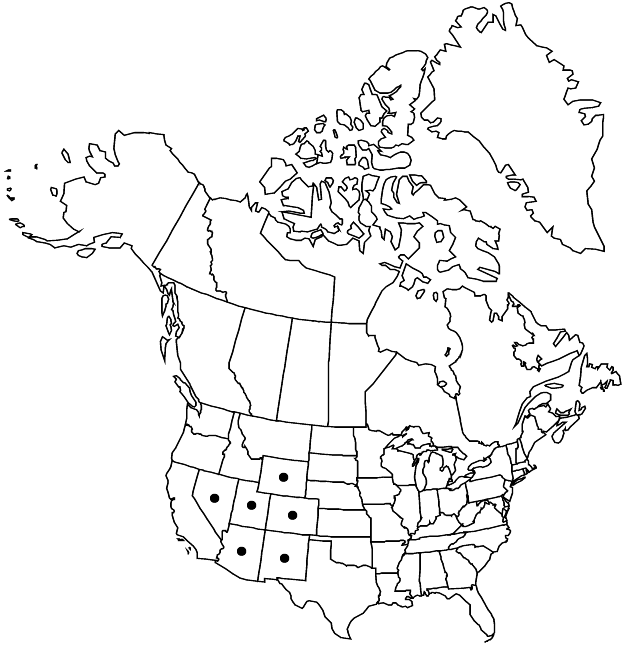Eriogonum corymbosum
in A. P. de Candolle and A. L. P. P. de Candolle, Prodr. 14: 17. 1856.
Shrubs or subshrubs, spreading, rounded, occasionally erect, rarely somewhat matted, not scapose, (0.5–)1.5–8(–15) × (2–)3–15(–23) dm, grayish- to reddish-brown-tomentose to floccose or glabrous, grayish or greenish. Stems spreading or erect, often with persistent leaf bases, up to 3/4 or more height of plant; caudex stems absent or somewhat matted; aerial flowering stems erect or nearly so, slender or occasionally stout, solid, not fistulose, (0.1–)1–2 dm, tomentose to floccose, occasionally glabrous. Leaves cauline, 1 per node; petiole 0.1–1.5 cm, tomentose to floccose; blade lanceolate to oblanceolate or elliptic to nearly orbiculate, rarely cordate, (0.5–)1–3(–4.5) × (0.3–)0.5–3(–3.5) cm, densely white-, tannish- or brownish-tomentose on both surfaces or less so to nearly glabrous and green adaxially, margins occasionally crenulate. Inflorescences cymose, rarely capitate or umbellate, diffuse to rather open, (1–)3–20 × 2–25(–30) cm; branches dichotomous, tomentose, floccose, or rarely glabrous; bracts 3, scalelike, usually triangular, and 1–3(–6) mm, or leaflike, 10–25 mm, and similar to leaf blades. Peduncles absent. Involucres 1 per node, turbinate, (1–)1.5–3.5 × 1–2(–2.5) mm; teeth 5, erect, 0.3–1 mm. Flowers (1.5–)2–3.5 mm; perianth white to cream, pink, or pale yellow to yellow, glabrous or rarely sparsely pilose; tepals connate proximal 1/4–1/3, essentially monomorphic, oblanceolate to spatulate; stamens included to slightly exserted, 1–4(–5) mm; filaments typically pilose proximally. Achenes brown, 2–2.5(–3) mm, glabrous except for occasional papillate beak.
Distribution

Ariz., Colo., N.Mex., Nev., Tex., Utah, Wyo.
Discussion
Varieties 8 (8 in the flora).
Eriogonum corymbosum is a difficult complex of overlapping expressions, some of which are maintained here as taxonomically significant. Although perianth color is used to group the varieties, this feature is not consistent even in single populations. Therefore, population trends in perianth color must be noted in the field. Most of the varieties are then distinguished on the basis of leaf characters, and again, considerable variation can be seen in some populations. Still, the combination of flower color, leaf features, and geographic distribution should prove useful in distinguishing the varieties.
S. L. Welsh et al. (2003) alluded to hybrid combinations involving Eriogonum corymbosum and other species. Aside from the instances involving E. brevicaule, discussed below, none has been confirmed. Most of the putative hybrids are misidentified specimens of E. lonchophyllum or collections of var. corymbosum in which the leaf-margins are not decidedly crisped, a feature usually seen only in fully mature plants.
Eriogonum corymbosum was widely used by Native Americans. P. A. Vestal (1940) reported that the Hopi pressed boiled stalks into cakes that, when dried, were eaten with salt. J. W. Fewkes (1896) indicated that boiled leaves were mixed with cornmeal and water, and then baked into a kind of bread. S. A. Weber and P. D. Seaman (1985) indicated that A. F. Whiting was aware of a decoction of leaves (probably from var. glutinosum) being used for headaches. Variety glutinosum also was used primarily to treat tuberculosis, or at least as a cough medicine (D. E. Moerman 1986).
Some of the expressions of Eriogonum corymbosum are attracting the interest of gardeners, a few are coming into cultivation, and several selections are now being developed. The plants are slow growing but can be transplanted with some degree of success. Members of the varieties are food plants for Ellis’s dotted-blue butterfly (Euphilotes ellisi).
Selected References
None.
Lower Taxa
Key
| 1 | Perianths usually pale yellow to yellow, occasionally white; s Utah, n Arizona, se Nevada | > 2 |
| 1 | Perianths white to cream or pink; sw Wyoming s through e Utah and w Colorado to nw New Mexico and Arizona | > 4 |
| 2 | Inflorescence branches glabrous or nearly so; sw Utah | Eriogonum corymbosum var. aureum |
| 2 | Inflorescence branches tomentose to floccose | > 3 |
| 3 | Leaf blades greenish-floccose adaxially; Colorado Plateau, n Arizona, s Utah | Eriogonum corymbosum var. glutinosum |
| 3 | Leaf blades silvery-floccose adaxially; Mojave Desert, se Nevada, sc Utah | Eriogonum corymbosum var. nilesii |
| 4 | Leaf blades elliptic-oblong to nearly orbiculate, 1-3(-3.5) × 1-2.5(-3.5) cm | > 5 |
| 4 | Leaf blades lanceolate to oblanceolate or elliptic, (0.5-)1-3(-4.5) × (0.3-)0.5-1.5 cm | > 6 |
| 5 | Leaf blades elliptic-oblong to oblong or ovate, rarely cordate, densely white- to tan-lanate or less so to brownish-floccose adaxially; plants brownish-white- tomentose; flowers 2-2.5(-3) mm | Eriogonum corymbosum var. velutinum |
| 5 | Leaf blades usually broadly ovate to nearly orbiculate, densely grayish-tomentose abaxially, sometimes tomentose to floccose on both surfaces, or more often subglabrous or glabrous and green adaxially; plants greenish-tomentose; flowers 2.5-3 mm | Eriogonum corymbosum var. orbiculatum |
| 6 | Plants sprawling subshrubs, 0.5-1.5 dm, occasionally shrubs, 2-4.5 dm; leaf blades 0.5-2 × 0.3-0.6(-0.8) cm; subalpine in bristlecone pine communities | Eriogonum corymbosum var. heilii |
| 6 | Plants erect subshrubs or shrubs, 3-10 dm; leaf blades 1-3(-4.5) × (0.3-)0.5-1.5 cm; desert scrub to montane forest communities | > 7 |
| 7 | Leaves cauline 2 or more length of flowering stems; n Arizona, w Colorado, e and s Utah, sw Wyoming | Eriogonum corymbosum var. corymbosum |
| 7 | Leaves cauline 4 or less length of flowering stems; c and e Utah | Eriogonum corymbosum var. revealianum |